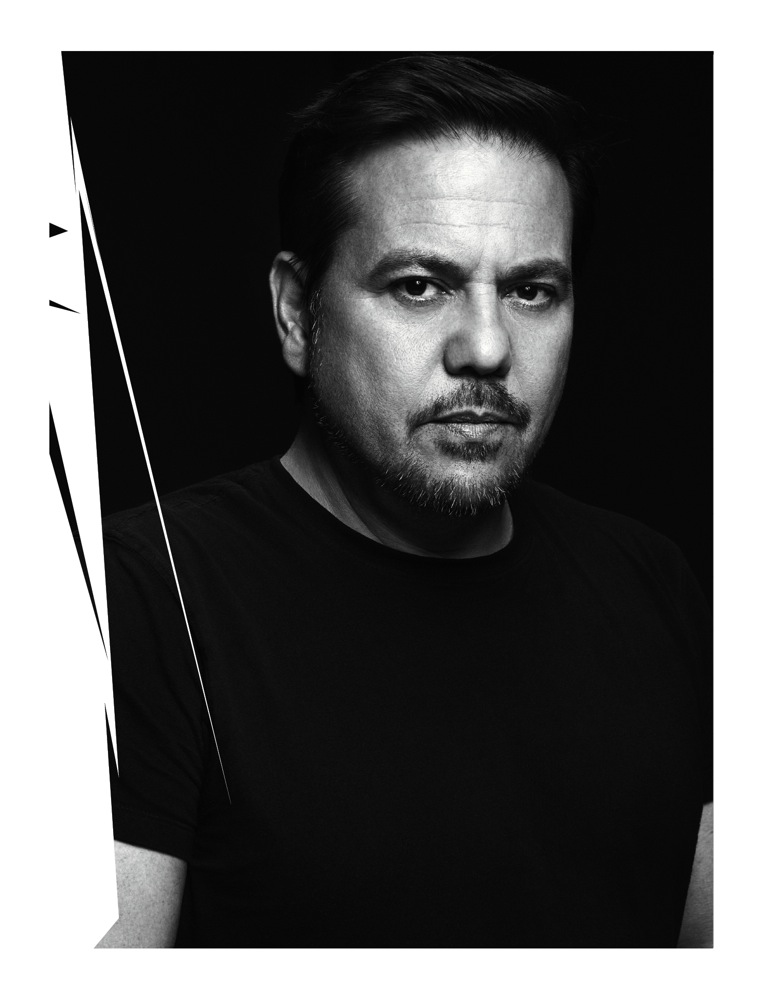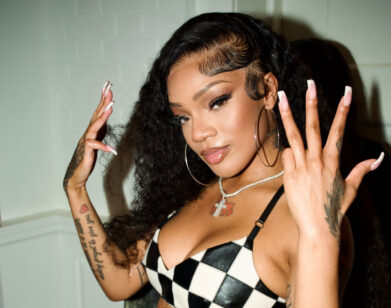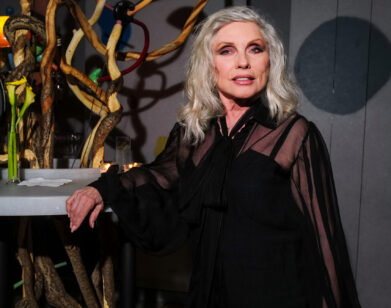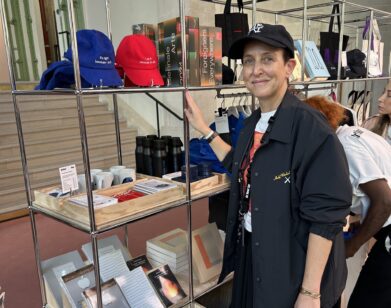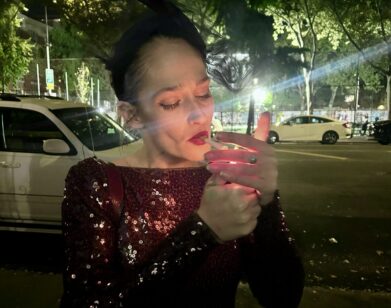Narciso Rodriguez
Sometimes I’ve even put the commerce at risk for the substance, because it’s what is lasting. It’s what is meaningful. Narciso Rodriguez
For more than 15 years, designer Narciso Rodriguez has been honing his own brand of minimalism, with sharp, tailored silhouettes and a saturated, graphic approach to color—drawn with an eye toward a certain purity of form.
Born in Newark, New Jersey, to Cuban immigrant parents, Rodriguez graduated from the Parsons School of Design in 1982 and started upon a career that eventually led him to Anne Klein (in its Donna Karan days), where he rose to become design studio director, and then to the studio of another minimalist master, Calvin Klein. An early major moment came in 1996 when he designed a dress for his friend and one-time colleague Carolyn Bessette for her wedding to John F. Kennedy Jr. The bias-cut silk crepe slip-dress came to embody what is now regarded as the essential Rodriguez: simple, sleek, and sculptural.
After stints at the European houses Cerruti and Loewe, Rodriguez debuted his eponymous line in 1997, and in the intervening years has become a favorite of high-powered women such as Cindy Sherman, Claire Danes, and Julianna Margulies, as well as first lady Michelle Obama, who wore a graphic black-and-red Rodriguez number on election night in 2008. Among the traits that have earned Rodriguez such a devoted following are his unapologetic embrace of the female body and his consistently novel approaches to shape, curve, color, and proportion—all center stage in his Fall 2013 collection. Appropriately, this year, Rodriguez, who also creates accessory and fragrance lines, is celebrating the 10th anniversary of his scent For Her—which, like everything he does, is clean, sensual, and classically feminine.
Another Rodriguez fan, the artist Rachel Feinstein, recently visited the 52-year-old designer at his studio in downtown Manhattan.
RACHEL FEINSTEIN: I wanted to ask you about modernism, because I love how you work in this incredibly clean, structural way. It’s about form, to me, and that’s what appears to be a modern element. Like, if you think about the Ingmar Bergman film Fanny and Alexander [1982] … Did you ever see that?
NARCISO RODRIGUEZ: Yeah.
FEINSTEIN: John [Currin, Feinstein’s husband] and I always talk about that movie as an exact description of two art forms that were happening at the same time, which was the end of rococo and baroque. The movie starts off with these children in this big, red-velvet, chintz-filled mansion. Everything is just, like, disgusting with gold and red and over the top, kind of like Liberace. And then in the middle of the movie, their father dies and the mother remarries a Calvinist Bishop who has a very modern, minimal house on a river. In the children’s room there’s just a little wooden desk—very Donald Judd, actually—with a wooden chair and a simple little cot, and the whole room is white and bare. So they go from this experience of their idea of warmth and love—of chintz and red velvet and gold—to this idea of coldness and sparseness. And when you think about modernity now, many art dealers and curators and collectors and artists want to live in that white, spare room. That’s their idea of what gives them warmth. But John and I are in this kind of funny leftover world by wanting the red velvet. And there’s this part of us where we’re ashamed of liking those things—that somehow when people who are modern look at rococo figurines, or they look at that scene with the red velvet mansion, or Liberace, it’s disgusting to them. I wanted to ask you about that because your stuff is so much about this beauty of form. How did it come about that that aesthetic is your vision?
RODRIGUEZ: It is from my childhood, definitely. I was raised in a very rococo, gold-leaf, crushed-velvet, red environment, not unlike the one you’re describing from the film. And my bedroom was the bone of contention in this Mediterranean, French-villa dream. It was white. It had a very brilliant royal-blue rug and black-and-white furniture. One wall had a very graphic black-and-white op-art thing going on. And it was strange for a kid to live in an environment like that.
FEINSTEIN: How old were you when you did that?
RODRIGUEZ: Maybe 11 or 12.
FEINSTEIN: And your parents let you do that?
RODRIGUEZ: Yeah. It took a lot of convincing.
FEINSTEIN: And how did that come about? How was the vision accessible to you?
RODRIGUEZ: I was always fascinated by graphic art and typography and architecture. And so I was constantly cutting things and making blocks and making buildings out of shoeboxes.
FEINSTEIN: Did people take you to see stuff?
RODRIGUEZ: No, I came from a lower-middle-class situation in Newark [New Jersey]. It was humble. But I think from those humble beginnings, I was able to create my own world. And I really loved things that were black and white. It wasn’t until recently that I made a connection through the early years, through different points in my career, where everything is about blocking a silhouette or an environment or a situation.
FEINSTEIN: I can understand that.
RODRIGUEZ: I realize that I live in the same environment that I did when I was a kid, but with less junk and better art.
FEINSTEIN: I think that all your ideas come from your childhood and your early teens and your early twenties, and you just figure out how to make them later in life. It’s this kind of weird concept that you don’t really have original ideas later on, but you become better at making them happen—through professionalism, through experience, through understanding. So, like, you always have to have a sketchbook around, especially as a young person, and you have to fill them up with stuff and then look at them later on in life, because it’s really shocking how you end up finding things that were ingrained in what you’re doing now. Do you do that, too?
RODRIGUEZ: We have these books here, which we always refer back to. There are boxes and boxes. These are just some that we refer to today. These are my books from Calvin [Klein], from my years there.
FEINSTEIN: Wow, that’s amazing. This is exactly what I was just talking about.
RODRIGUEZ: There’s fabric, proportions …
FEINSTEIN: So this is like a bible.
RODRIGUEZ: Well, yeah, these journals have become inspiration. It was really the change in fashion where sort of the street, sort of the skateboarder started to influence what was going on in fashion. I’ve also been taking pictures since I was a teenager. There are boxes and boxes of film.
FEINSTEIN: How do you feel about the commercialism of fashion now? Everything has become so global. Do you ever feel that your vision has to be changed in any way? Or do you get to do exactly you want?
RODRIGUEZ: I think more and more that I get to challenge myself and kind of raise the standard for myself every season. Even the term fashion is about change. It’s about newness. And what that newness means is different every 10 years, every five years. Over the past five years, it’s been sort of a more democratic fashion experience, where anybody who can Krazy Glue sequins onto feathers can go on TV, or any factory in any third world can be a designer. And there are hundreds of fashion shows. When you really look, there’s a lot of noise, but some people who are still true to the concept of design—
FEINSTEIN: And what it’s really about.
RODRIGUEZ: And those are the people I certainly admire and think are brilliant. [John] Galliano, [Nicolas] Ghesquière, Alber Elbaz … People like Maria Cornejo, Raf [Simons] …
FEINSTEIN: [Azzedine] Alaïa …
RODRIGUEZ: Alaïa—still doing his thing.
I don’t ever work on a season that’s full of ideas from that season only. The ideas can come from as far back as 20 years. Narciso Rodriguez
FEINSTEIN: It’s interesting because in earlier eras, when there were depressions of different types—you know, the wars—people withdrew into movies and maybe dance and opera. And now it seems that no one goes to those things anymore, but they do look at fashion shows, online and on YouTube, and they go to the art fairs … So I was thinking, why is there this incredible middle-class need for things that were so high class before?
RODRIGUEZ: I think it’s show business. And people can build an empire catering to that type of show business. It’s just a very different world to the one that I live in. I’m so fortunate that I live in New York and have access to all the great art, and I get to travel, even if it’s for work, to Italy, and I go to Florence to work on accessories. I never have to see the commercialization at that level, and I try to stay away from it. I mean, I’m aware of it. As a businessman, I’m conscious of everything that is the fashion industry. But it’s not what I do.
FEINSTEIN: Does it bother you? Or do you just accept it?
RODRIGUEZ: You know, I’ve learned that mediocrity has a shelf life.
FEINSTEIN: I agree with that.
RODRIGUEZ: So often you see “all the rage” discarded so quickly, because there is no real substance to it. I know you’ll understand this—for me it is about the substance. And sometimes I’ve even put the commerce at risk for the substance, because it’s what is lasting. It’s what is meaningful. It’s what drives you forward as an artist. It’s what inspires other people.
FEINSTEIN: It’s beauty.
RODRIGUEZ: It’s beauty. It’s what gets everyone to come to the shop and to respect what you do.
FEINSTEIN: Well, what also put you on the map was that beautiful bias cut you did for Carolyn Bessette Kennedy’s wedding dress. I remember when I saw that on the cover of People magazine, I wasn’t like, “Oh, she got married,” I was like, “Wow, that is an incredible dress …” Nobody else was doing that whole sculptural, structural line—this idea of form. Do you start with a form and stick to the form? Or do you change it as you’re working it?
RODRIGUEZ: I think it varies. I mean, there are rules to the game for me. Today, one of my main directives when we’re working here and we’re talking about what we’re doing or the next season, is that every piece be so desirable that you covet it. Sometimes you can create things that are better than others. I think when you create the thing that everyone in the room wants or is excited about, that feeling really translates into a magazine or a fashion show, and ultimately to a woman who is actually wearing it, and then keeps it, not just for the season, but for a long time. That is something that is sort of a new facet to the game. But there is form, and there’s architecture, and there’s beauty—all of those elements are, I guess, in equal parts. I never want to forsake one for another.
FEINSTEIN: How does it start, though, with a new season? Is there just an idea? Do you see a movie that inspires you, an artwork?
RODRIGUEZ: You know, we do four seasons a year …
FEINSTEIN: Yeah, that’s incredible. I can’t understand how you do that. [laughs] I do a show once every two years.
RODRIGUEZ: You’re so lucky.
FEINSTEIN: I think you guys should start a revolt and do that as well.
RODRIGUEZ: Well, I’m fortunate because I have an incredible team I work with who allow me the time in the morning to walk around the city and take pictures and send them back to the office. It’s a constant search. It’s on the street. While I was in New York for the last Fall show, I happened to be standing at a bike partition in the middle of Eighth Avenue, and I looked back and the light was beautiful. I saw a girl walk out of a store and start walking this way, and another girl walking this way, and it looked like they were on a runway. It was about color, they weren’t dressed in fashion. I quickly shot a picture of these girls, and it really inspired the last collection. It was the one starting point.
FEINSTEIN: It’s mostly visual for you then? It’s not about any kind of plot or anything like that?
RODRIGUEZ: I had the good fortune to have business in São Paulo last year. I was there for a few days and it coincided with their Bienal. It was curated by Luís Pérez-Oramas, from the MoMA. He did an extraordinary thing—he created something that was epic. And I’m obsessed with Latin American modernism …
FEINSTEIN: It is really cutting edge in a lot of ways.
RODRIGUEZ: I loved Lygia Clarke and Hélio Oiticica … Just so many artists through the years. And I had a home in Brazil, so it made it very easy for me to investigate the architecture in Brazil. So I would go through the years and visit. I went to see Lina Bo Bardi’s Glass House and I met Oscar Niemeyer. But to fast-forward, I was in São Paulo and I kept going back to the Bienal and seeing all of this work. I took so many pictures and so many films. And I came back and exploded it all onto the walls here. It really influenced the way I think about color, and the rawness of Brazil goes into it as well. It was a multi-inspirational experience, because you’re there for one reason, and then I got to see so many things that I had only dreamed of.
FEINSTEIN: We come from similar backgrounds, in that Jewish and Cuban is a very similar thing. [laughs] I grew up in Miami, which we’ve talked a little bit about—everything about Cuban Miami and Jewish Miami is dripping with red chintz. You think it’s similar to Brazil, or is it not? This idea of too much visual sensation, in a way, and then the opposite is this Glass House in a place like Brazil, with the jungle, with everything. You’ve got these two opposing things going on.
RODRIGUEZ: What struck me on one of my first jaunts around Rio was you had this rococo structure downtown next to this ’80s high rise next to this crazy Flying Down to Rio ’30s film musical … In my youth, I was obsessed with the glamour of that film—this beautiful fantasy place.
FEINSTEIN: That’s so interesting that that was your fantasy because probably so many people were having this other fantasy of a Bavarian castle.
RODRIGUEZ: It wasn’t until I was there, standing on one of the hills looking down, that I realized that my childhood obsession was to go to Brazil. I had collected all these books and things, and now I’m looking out over this crazy landscape, because geographically it’s staggering, and it just profoundly moved me. And I started to connect all the abstract things, like, yes, I knew who Niemeyer was, but I didn’t think that I’d be standing in front of his apartment building, or be at the Bienal in the space that he designed. You’re just constantly reminded of all these incredible moments in the history of great design.
FEINSTEIN: That’s maybe where the rococo comes in for you—maybe the fact that it’s in Brazil itself. It’s a wild place, Brazil, isn’t it? It’s pretty free.
RODRIGUEZ: For a good portion of my life, it has inspired my work.
FEINSTEIN: Do you spend a lot of time there now?
RODRIGUEZ: I did, but not now. I travel more in the United States and Europe now. I gave up my home there this past summer, which was bittersweet. But I still got to go back this fall, and I’ll probably be there sooner than you know it, because it’s the place where I felt most at home, next to my home here.
FEINSTEIN: And so what do you do for relaxation? Do you have a place upstate?
RODRIGUEZ: Yeah, I have a place in Westchester. It’s very woodsy and peaceful. There are deer, foxes, coyotes, turkeys …
FEINSTEIN: Do you draw up there? Do you read?
RODRIGUEZ: I do. The office is a creative space, but there is the function of business here. So what happens is the machine works all day, and then the creative machine clicks on automatically at 6 P.M. and weekends. I have an amazing partner and an amazing life at home, so it wasn’t even like a forced issue, it just happened naturally that a balance was struck. So the weekends and the evenings are free for family. Which has made me quite sane and my life very happy.
FEINSTEIN: I have a question that has to do with the whole thing of workshops and these big factories of artists—like, Jeff Koons supposedly has 150 people working for him now. I have a really hard time having people in my studio, because I just can’t think. I have very little free time as it is with three kids and a husband and all this kind of stuff, so that when I come to my studio, it’s like my sanctuary, and I really want to sit there and think about what I want to do. Do you get that here? How do you manage a business that’s creative with everybody waiting for you to tell them what to do?
RODRIGUEZ: Well, we function because of creativity. We don’t have 150 people filling out tech packs and spec sheets to send to Asia. We actually have a workroom. We drape those things, we create those things.
FEINSTEIN: But do you ever feel anxiety that people are sitting around waiting for you to inspire them or tell them what to do? It’s such a strange thing—a creative job with lots of people working for you.
RODRIGUEZ: Yeah, but it’s a team. It’s like a cult—we all believe in the same thing, and we’re all talking about the same thing, and we’re headed in one direction. Some of us bring abstract things to the table, so I may be on some tangent and they’ll bring me back to reality. Ultimately, we all want to make beautiful things and dress women, and not just put on fashion shows with clothes that nobody is ever going to wear. I want to present those things so that you want every one of them, and I want to see you in those things.
FEINSTEIN: When you’re thinking about who you’re making it for, is it always the same type of woman?
RODRIGUEZ: Most designers, I guess, you would speak to today are desperate to dress a cool, young, downtown fashion editor—and I love her, she’s always inspiring—but I want to dress her and her mom. I want to dress every woman. I think there rarely is one woman, because I’ve been inspired by so many amazing women. Yourself …
FEINSTEIN: Thank you.
RODRIGUEZ: Carolyn [Bessette Kennedy], Cindy [Sherman], Jessica Alba, Rachel Weisz, Claire Danes, Julianna Margulies …
FEINSTEIN: All really smart, amazing women.
RODRIGUEZ: I dressed Claire for her first Academy Awards, when she was 17. And we’ve remained really good friends for more than half of her life. Which kind of blows my mind, because I feel as young as I did when I met her, and now she has a child.
FEINSTEIN: How did it start with the idea of dressing women, versus being an artist or an illustrator or a photographer?
RODRIGUEZ: Well, there was commercial art and graphic design and photography and illustration and fine arts and architecture, and as a kid does, I went from one thing to another. Then I discovered the work of Antonio Lopez, and I saw that illustration could be so glamorous and chic, and it was about fashion. I was fascinated. So I segued from illustration to fashion illustration, and I studied all different kinds of painting.
FEINSTEIN: Your drawings are beautiful. I can see that you could do that if you wanted to.
RODRIGUEZ: I don’t know how it happened, but it was something very profound for me. All the things I loved—how to put up a building, how to choose materials to go into a building, and the building process—sort of flipped into doing that to beautify or to create that exciting thing that you need to covet.
FEINSTEIN: But why is it that not many designers talk that way about making clothes for men? Is a woman’s body more interesting? Is it something about the shape of a woman’s hips?
RODRIGUEZ: Oh sure. I was raised as a Latino, surrounded by all of those great bodies. I remember having a great aunt who didn’t have the means, but had the style. She had an amazing Chanel-like suit and the jangly charm bracelets and great lipstick and pointy stilettos and a beehive. You’re surrounded by those bodies and those personalities and that force … Certainly all those Latin women were a source of inspiration.
FEINSTEIN: Just the balls of the breast—you have two balls. And then you have two balls of the butt, and then the hips that have balls. And it’s this kind of idea of round shapes on something that—
RODRIGUEZ: We call them curves.
FEINSTEIN: Curves! [laughs] In terms of also the progression of models, if you think about late ’80s, the models were bigger women.
RODRIGUEZ: Older.
FEINSTEIN: And breasts. You think about Cindy Crawford and Elle Macpherson—they were not rocking the runway as much …
RODRIGUEZ: But even before those girls, models like Jerry Hall and Betty Lago, Iman …
FEINSTEIN: Personalities.
RODRIGUEZ: Beverly Johnson, Dayle Haddon … But they were, you know, women. The proportions were just so radically different.
FEINSTEIN: Why do you think that is? I mean, the models are so different than they were even in the ’90s, like, when Kate Moss started, with the trend of these more waiflike girls. They’ve even gotten younger and thinner and smaller it seems to me. Is the emphasis more on the clothes and less on the girls? Have the clothes changed with the girls?
RODRIGUEZ: Well, the clothes change constantly. But, I mean, you can wear whatever you want, as long as you have style you can look good.
FEINSTEIN: Which is actually one thing I’ve always loved about the fashion world. The art world, because of having that time to make shows and think about things, sometimes they take themselves just a little too seriously. You get hung up on a detail that, really, in a hundred years, doesn’t fucking matter. And in fashion, sometimes the fastness of everything makes it stronger, because you’re forced to just deal with it, you know?
RODRIGUEZ: Well, when you create a painting or a sculpture or you build a home, something that I find fascinating is the sort of unspoken longevity that enters into the process. Whereas when we create, especially today, when fashion can be so fast and disposable, it doesn’t really matter—you can copy someone else’s gimmick. But when you’re forced to or want to create things that have more substance or longevity to them, it’s a different process. I don’t ever work on a season that’s full of ideas from that season only. The ideas can come from as far back as 20 years. Yes, you’re on a schedule, there’s the urgency, and especially when it’s show time, you’ve got to work it out fast, but those ideas have evolved from one small idea and were done three different times before it became the idea that you’re looking at today.
FEINSTEIN: I understand.
RODRIGUEZ: It’s the part of my job that, now that I’m a little bit older, I appreciate the most. Because when I look at fashion and runway shows today, there’s a lot of reflections of other people’s runways, because it is disposable and a little bit meaningless.
FEINSTEIN: It’s the theater.
RODRIGUEZ: And then next season it’s something else. I try to avoid that as much as possible and keep evolving the ideas and the lines that are unique to my work. When I speak to students, I tell them, “You have to find that thing you believe in, whatever it is, and if it’s emulating the next person’s runway, that’s fine too. You have to follow that and keep evolving that one thing.” I mean—off the record—when I look at John [Currin]’s work, the part that always blows me away is how he’s taken you and evolved you into so many beautiful creations.
FEINSTEIN: Oh no, you can totally keep that in. He’d love it. [laughs]
RODRIGUEZ: Okay, it’s not off the record.
FEINSTEIN: Let me see if I have any other questions … Oh, yes, fragrance: Many years ago, John and I were asked by a perfumer to come in to see what we would respond to, because he was trying to figure out something new. It was incredible. Do you do that for your perfume?
RODRIGUEZ: Well, I was approached to create a fragrance 13 years ago, and it’s become a very big portion of my career. I remember traveling to Russia back in 2000 and all these people were waiting for me, excited, and I thought, My god, what are they waiting for? They knew me mostly through a fragrance. It’s really one of the facets of this design house that I’m proudest of. The idea for the fragrance started with a musk I used when I was about 15. I remember buying it on Eighth Street and always being fascinated by how mysterious musk is …
FEINSTEIN: It’s very sexual-musk—which I like a lot.
RODRIGUEZ: So I had this idea that I would take certain flowers and mix it with musk. That was when I was on Bond Street. I sat with these great noses and we created different fragrances until we hit the one I thought best represented the idea. And I got to work with Inez and Vinoodh to create the shot that’s—
FEINSTEIN: I remember that picture so well.
RODRIGUEZ: It’s such an iconic moment. That was shot in 2000. It was about beauty and timelessness.
FEINSTEIN: Which is what fragrance is about. You associate experiences with meeting someone the first time based on how they smell. For some people, it’s even more alluring than a visual experience. My father always talks about how my mother used to wear this vanilla scent, and my father loves food. I’m just like him! [laughs] He remembers exactly the moment he saw her based on her smelling like a creampuff. And they’re still together and madly in love, and he still loves food, and she still wears a vanilla scent. There’s such an association of sex and warmth based on someone’s smell.
RODRIGUEZ: And imagine what they did …
FEINSTEIN: I know … The creampuff.
RACHEL FEINSTEIN IS A NEW YORK-BASED ARTIST WHO SPECIALIZES IN SCULPTURE.
For 12 things Narciso Rodriguez can’t live without, click here.

